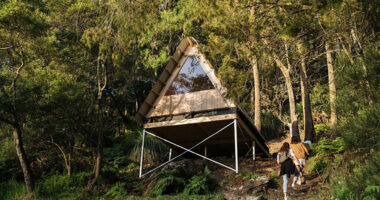Introduction
Nestled in Kanoya, the bustling heart of Japan’s southernmost peninsula, stands the Kotobuki Hotel—a testament to adaptive reuse and architectural innovation. Designed by micelle and unveiled in 2020, this hotel exemplifies the marriage of modernity with the rich tapestry of local heritage.

Contextual Background
Situated amidst a landscape marked by vacant lots and a dearth of tourism resources, the Kotobuki Hotel emerges as a beacon of revitalization and renewal. Born out of the need for a budget-friendly business hotel, its creation breathed new life into the local community, offering a vibrant hub for both visitors and residents alike.

Architectural Vision
Lead Architect Katada Tomoki envisioned a space that transcended the mundane, striking a delicate balance between novelty and sophistication. The hotel’s extension, cleverly positioned across a gap between existing structures, fosters an atmosphere of diversity and intrigue. By embracing varied elevations and distorted shapes, each building exudes its own distinct aura, enriching the streetscape with a sense of dynamism.

Embracing Contradictions
Echoing the ethos of chaos and affinity, the Kotobuki Hotel welcomes guests with an eclectic fusion of indoor and outdoor finishes. Recognizing the diverse backgrounds of its patrons, the design celebrates openness and inclusivity, eschewing uniformity in favor of a multifaceted tapestry of textures and styles. This deliberate juxtaposition of elements creates an environment that is at once comfortable and compelling, inviting exploration and interaction.

Crafting Spatial Dynamics
Within the hotel’s confines, objects are organized into distinct groups, each characterized by subtle variations in size, texture, and style. These intentional contradictions serve as catalysts for engagement, fostering a sense of intrigue and tension that permeates every corner. By embracing the nuances of spatial relationships, micelle creates a narrative of inclusion and exclusion, offering guests a fresh perspective on the complexities of consumer society.

Conclusion
The Kotobuki Hotel stands as a testament to the transformative power of architecture, where adaptive reuse and renovation breathe new life into forgotten spaces. With its bold vision and commitment to diversity, micelle has crafted not just a hotel, but a dynamic canvas where tradition and innovation converge. As guests traverse its halls, they embark on a journey of discovery, where every corner tells a story and every contradiction invites exploration.



























